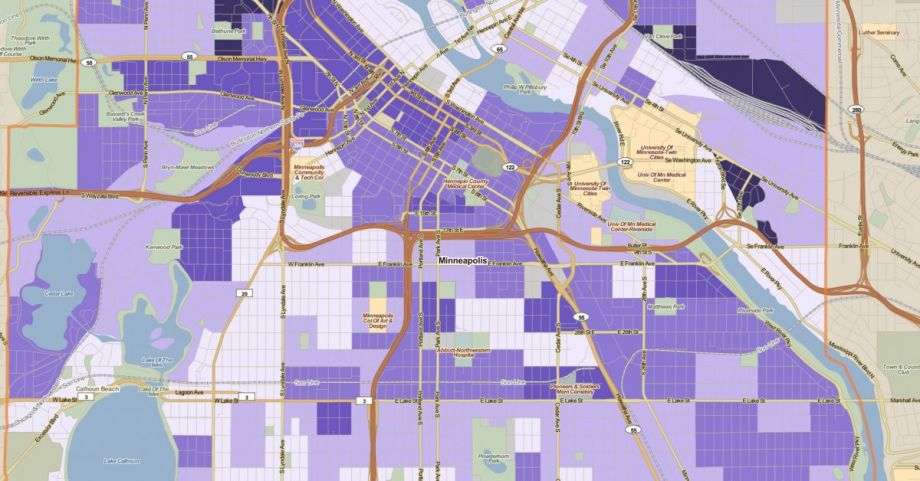The visualization looks like a spreading cancer, slowly choking the city of Minneapolis. It starts in 1910 and moves through the mid-1950s, with blue splotches showing the growing presence of racially restrictive deed covenants, legal documents that prevented black people from buying or occupying homes. As Next City reported in 2017, researchers have slowly been identifying all of those deed covenants in the Minneapolis area as part of a project called Mapping Prejudice. At the end of last year, after 3,000 volunteers had put in roughly 14,000 hours, the team finally finished identifying all of the covenants in Hennepin County. Today, the project is one more reminder of the deep racial inequalities that contradict the city’s self-image as a bastion of progressive politics.
“Looking at these material realities really does fly in the face of what white progressives believe about themselves,” says Kirsten Delegard, the Mapping Prejudice project director. “And the way that our project is structured, with mapping, you can’t mistake it for anything other than what it is, which is a material expression of white supremacy.”
The most recent expression of the Twin Cities’ racial divide was the gruesome murder of George Floyd by a white police officer in the Minneapolis Police Department. The killing has sparked an uprising in Minneapolis — which has involved everything from the burning of a police station to the cancellation of the Minneapolis School District’s contract with the police department to the Minneapolis City Council’s light-on-specifics announcement that it had a veto-proof majority to disband the police — and protests all around the country. There were also protests after a police officer killed Philando Castile just outside of Saint Paul in 2016, and again after that officer was acquitted. What’s striking this time, Delegard says, is how few people are writing off the killing of George Floyd as a rogue officer, “one bad apple” in an otherwise good bunch.
“These institutions are rotten,” she says. “Structural racism has permeated every institution in the city. And the discussion is, what are we gonna do?”
When he took office in 2018, Minneapolis Mayor Jacob Frey created a task force on affordable housing and framed its recommendation, to add $50 million of local money to the city’s housing budget, as a means of chipping away at the racial segregation that defines the city’s neighborhoods. Since then, the city council approved a budget with more than $40 million for housing efforts, and last fall, it voted to spend $18 million from the expanded Affordable Housing Trust Fund on 12 housing projects including more than 1,000 units, according to the Star-Tribune. The city also made national headlines for adopting a comprehensive plan that recommended undoing single-family zoning across the city. But housing advocates are still trying to push through tenant protections like just-cause eviction rules and rent control, while acknowledging that housing inequality can’t be undone by housing policy alone.
“There’s a lot of frustration with the idea that this comprehensive plan changed anything in terms of power dynamics between folks who are trying to find housing or stay in their community, and the forces that are pushing them out or forces that are preventing them from finding housing,” says Owen Duckworth, director of organizing and policy at The Alliance, a coalition of community groups focused on regional equity.
As part of The Alliance’s Equity in Place policy agenda, the groups have been pushing for a Tenant Opportunity to Purchase Act, which would give tenants the right of first refusal when their building owner plans to sell, similar to laws in Washington, D.C., and San Francisco. (In D.C., a small study looking at 7 buildings that used TOPA since 2000, researchers found that about half the units, or about 1,500 households, remained occupied by the same tenants.) The agenda also includes community control of land and housing through community land trusts, reforming tenant-screening processes, and increasing funding for community organizing work. Even when jurisdictions have taken an explicitly anti-segregation approach to housing work, it’s often meant destroying housing in inner cities and breaking up communities of color, Duckworth says. An effective strategy would require cities like Minneapolis to invest directly and intentionally in housing for low-income people of color, rather than hanging all their hopes on increased density and inclusionary zoning rules, Duckworth says.
“There’s been a building powder keg around these things, and I think even a lot of well-intentioned white progressives in this city haven’t really been hearing communities and understanding and taking intentional steps to address the amazing breadth and depth of structural racism and how it lands in our communities here …” he says. “City zoning codes aren’t going to change all of these things, that’s for sure.”
In Powderhorn, the neighborhood where Floyd was killed, many residents and business owners were already struggling to make ends meet before the coronavirus pandemic began, says Grace Berke, a community coordinator with the Powderhorn Park Neighborhood Association. The challenges have been compounded by the pandemic. The association has been running a Renter Support Fund open to all Minneapolitans for several years. To truly address the disparities in access to housing, the city will have to make “investments that aren’t market-based,” Berke says.
“Mayor Frey and his administration continue to not be honest with the true investment that’s needed, from a policy and budget standpoint, to really move the needle,” Berke says.
Hope Community is a nonprofit group that provides affordable housing and focuses on “placekeeping” advocacy work based in South Minneapolis, and a member of The Alliance. Shannon Smith Jones, the executive director of Hope Community, says that housing is “super foundational … and it’s an indicator for everything else.” Disparities in housing will always correlate with other disparities in society. And while the city’s push to add more money to affordable housing efforts was welcome, everyone knew it was a limited strategy, she says. The uprising in Minneapolis has only emphasized the need for more dramatic change.
“Right now I think there is something that might be in the air,” Jones says. “The soil might be a little more ready for investment — and not even just investment. I hesitate to use the words ‘reparations,’ but our communities have been extracted from for centuries. It’s not even an investment, but a righting of the wrong — putting back resources that were taken … I feel as if there might be opportunities right now for people to really put their money where their mouth is.”
In the meantime, Jones says, she and others at Hope Community have begun talking about how to create a “healing space” in the community. The community has been “in constant trauma mode” since the killing of George Floyd, which is compounding the traumas that communities of color already live within, from everyday interactions with racist police and institutions to disparities in health, education, and employment that are particularly stark in Minneapolis. If people don’t have opportunities to talk about trauma, it manifests physically, in their bodies, Jones says.
“The systems are supporting the demise of black and brown people …” Jones says. “I think we’re all stuck in systems that have been created and already exist, and we need to give time and space to dream a different dream.”
This article is part of Backyard, a newsletter exploring scalable solutions to make housing fairer, more affordable and more environmentally sustainable. Subscribe to our weekly Backyard newsletter.

Jared Brey is Next City's housing correspondent, based in Philadelphia. He is a former staff writer at Philadelphia magazine and PlanPhilly, and his work has appeared in Columbia Journalism Review, Landscape Architecture Magazine, U.S. News & World Report, Philadelphia Weekly, and other publications.
Follow Jared .(JavaScript must be enabled to view this email address)


















